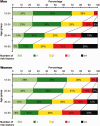Ischemic stroke in the young: Current perspectives on incidence, risk factors, and cardiovascular prognosis
- PMID: 31008265
- PMCID: PMC6301217
- DOI: 10.1177/2396987316629860
Ischemic stroke in the young: Current perspectives on incidence, risk factors, and cardiovascular prognosis
Abstract
About one-fourth of ischemic strokes occur in working-aged individuals in the high-income countries, with worldwide increasing incidence in this age group from 1980s to present. Recent evidence suggests that traditional vascular risk factors are more prevalent than previously suggested in young adult stroke patients and they accumulate with age particularly in men. Accordingly, relatively high rates of atherosclerotic changes have been detected in these patients. The strength of association of vascular risk factors has gone poorly studied, however. Many young patients with ischemic stroke have, in turn, no traditional risk factors, while they may harbor other conditions with weak or uncertain association with the stroke alone. These individual conditions often represent a risk factor that may be strictly young-age specific, more prevalent in younger than older stroke patients (e.g. patent foramen ovale), or more prevalent among the young in the population. Despite high rates of vascular risk factors and atherosclerotic changes, these findings do not translate to higher frequencies of identified classical stroke mechanisms. In fact, cryptogenic causes are markedly common and even more frequent among the very young patients. Limited randomized trial evidence exists to support secondary prevention decision-making in patients, yet they face an increased risk of death and future vascular events for years to come-dependent on risk factor profile and cause of the stroke. This review provides an overview of recent data on epidemiology, risk factors, and their strength of association in ischemic stroke in the young. Furthermore, the relationship between with the risk factors and cardiovascular outcomes and key features on the evidence related to secondary prevention will be discussed.
Keywords: Stroke in young adults; incidence; patent foramen ovale; pathogenesis; prognosis; risk factors.
Conflict of interest statement
The author(s) declared no potential conflicts of interest with respect to the research, authorship, and/or publication of this article.
Figures



References
-
- Rosengren A, Giang KW, Lappas G, et al. Twenty-four-year trends in the incidence of ischemic stroke in Sweden from 1987 to 2010. Stroke 2013; 44: 2388–2393. - PubMed
-
- George MG, Tong X, Kuklina EV, et al. Trends in stroke hospitalizations and associated risk factors among children and young adults, 1995–2008. Ann Neurol 2011; 70: 713–721. - PubMed
-
- Vangen-Lonne AM, Wilsgaard T, Johnsen SH, et al. Time trends in incidence and case fatality of ischemic stroke: the tromso study 1977–2010. Stroke 2015; 46: 1173–1179. - PubMed
-
- Bejot Y, Daubail B, Jacquin A, et al. Trends in the incidence of ischaemic stroke in young adults between 1985 and 2011: the Dijon Stroke Registry. J Neurol Neurosurg Psychiatry 2014; 85: 509–513. - PubMed
Publication types
LinkOut - more resources
Full Text Sources

